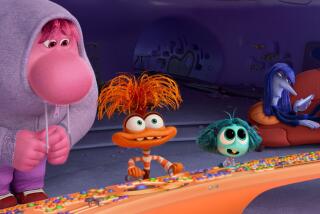The Future of Television: It’s All a Blur
- Share via
There’s an evolution underway.
Not a revolution, an evolution--a new kind of viewer, one not fully revealed, which explains why Big Four programmers have failed to come up with more than a handful of hits in the past few seasons and why their audiences are eroding.
Viewers are morphing--in the throes of an almost violent metamorphosis sparked by technology.
And all anyone can do is sit back and wait. But we are clearly in the thick of it.
Battered and at the same time enthralled by a medium gone haywire, the traditional American TV watcher, the ones who sat down with the family with a schedule of favorite shows in mind, who knew what to expect from the set, have been multi-tasked and multiplexed out of existence.
In their transitional place is the new American viewer, an overloaded creature, one rewired by technology into a port for hundreds of thousands of signals.
Unfortunately, all the viewer can do is blink in stunned reaction and try to keep up.
*
It begins with choices. Too many choices, too many worlds coming out of the same box at the same time. The television set is no longer a place of comfort and respite, a personable, easygoing entertainment alternative, though that’s the way so many remember it.
It’s a potential war zone where morality and codes of conduct change between channels. In split seconds. It’s a Molotov cocktail of mixed signals. Unpredictable. A land mine in the middle of our living rooms where explosive, deeply disturbing images can burst onto the screen at any moment.
Live television carries death, destruction, violence--from soccer riots to war and starvation--and it comes in a torrent. It washes through the evening news to the tabloids reaching into topical prime-time, albeit fictional, programming.
And viewers are still trying to figure out how to use their VCRs, the parental control box and the channel changer.
Television has grown tentacles, too--computer Web sites that have further altered the TV picture, even supplanted it. With VCRs and now home computers draining viewers’ attention and time away from the tube, television is losing some of its energy, its influence (even as it continues to grow) and its viewers.
Its power base, once centered in network television, has been depleted.
Put in the most basic terms, by the time a viewer has scanned the 200-channel horizon and decided what program to watch, the show is half over.
*
In a failed attempt to literally hook viewers as they fly by, programmers have tried everything from yelling to front-loading dramatic stories to eliminating theme songs.
All in vain.
There is more change, more technology to come, with the focus continuing to move away from what is on to how it got there.
High-definition television, a merging of computers and television--it’s all on the way. It’s already begun. More programs, more access to video, more venues.
To most viewers, it’s already a blur.
Which means there will have to be a new approach.
A new way of watching.
The first issue will be one of control, a way to funnel information into a mainframe of entertainment, news and family priorities.
The old ways, the random search for prime-time fun, what used to be a walk in the park, is now analogous to climbing Mt. Everest.
*
And it can’t go on much longer.
The Big Four, hoping against hope that their piece of the mountain doesn’t crumble further, are holding their ground by endlessly repeating themselves, by embracing the familiar.
It isn’t working, as will become evident next fall yet again, as obvious as the millions of viewers hurtling by on their way to something new and different.
But many will get lost somewhere between the grounded past and the high-flying future.
All they can do is wait.
Wait and watch.
What and how? That’s what the new viewer will have to decide.
More to Read
The complete guide to home viewing
Get Screen Gab for everything about the TV shows and streaming movies everyone’s talking about.
You may occasionally receive promotional content from the Los Angeles Times.






